Species Conservation
Adam's Cave
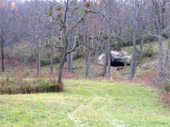 Located in Madison County, Kentucky, near the City of Richmond, Adams Cave (see photo by Brent Harrel/USFWS - left) contains a unique Bluegrass Region Located in Madison County, Kentucky, near the City of Richmond, Adams Cave (see photo by Brent Harrel/USFWS - left) contains a unique Bluegrass Region 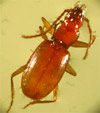 cave ecosystem. However, the cave had been vandalized repeatedly and contained an unbelievable amount of debris and garbage (e.g., candles, beer cans, etc.) that had been brought into the cave by the vandals. This disturbance threatened to destroy the only known habitat of the greater Adams Cave beetle (Pseudanopthalmus pholeter) (see photo by Brent Harrel/USFWS - right) and lesser Adams Cave beetle (Pseudanopthalmus cataryctos). In order to prevent this habitat destruction, SCC partnered with the Kentucky State Nature Preserves Commission, the U.S. Fish and Wildlife Service (USFWS), and others to acquire the site through a direct donation from the landowner, erect a bat-friendly, steel gate at the cave’s entrance (see photo by Brent Harrel/USFWS - left), and conduct an outreach cave ecosystem. However, the cave had been vandalized repeatedly and contained an unbelievable amount of debris and garbage (e.g., candles, beer cans, etc.) that had been brought into the cave by the vandals. This disturbance threatened to destroy the only known habitat of the greater Adams Cave beetle (Pseudanopthalmus pholeter) (see photo by Brent Harrel/USFWS - right) and lesser Adams Cave beetle (Pseudanopthalmus cataryctos). In order to prevent this habitat destruction, SCC partnered with the Kentucky State Nature Preserves Commission, the U.S. Fish and Wildlife Service (USFWS), and others to acquire the site through a direct donation from the landowner, erect a bat-friendly, steel gate at the cave’s entrance (see photo by Brent Harrel/USFWS - left), and conduct an outreach 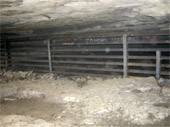 program to dissuade future vandalism and trespass at the cave. As a result of these efforts, trespass and vandalism have been eliminated and habitat for these two rare cave beetles has been protected. program to dissuade future vandalism and trespass at the cave. As a result of these efforts, trespass and vandalism have been eliminated and habitat for these two rare cave beetles has been protected.
In addition, SCC entered into a Candidate Conservation Agreement with Assurances (CCAA) with the USFWS to guide future management of the cave and has worked with the USFWS to restore natural habitats in the areas surrounding the entrance to the cave. Implementation of the CCAA allowed the USFWS to preclude the listing of both beetles under the Federal Endangered Species Act.
Protection and restoration of this site will address three primary goals:
- To protect habitat for two candidate cave beetles;
- To reduce vandalism and trespass within a unique cave ecosystem; and
- To provide opportunities for education and outreach relative to cave and karst conservation and protection.
Camp Pleasant
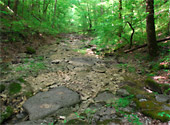 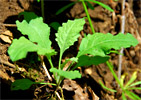 Camp Pleasant is located in Franklin County, Kentucky, just north of Frankfort. This 134-acre site contains one of the best occurrences of the federally endangered plant, Braun's rock-cress (Arabis perstellata) (see photo by Don R. Morgan/USFWS - right). In order to acquire the site, SCC secured a grant from the Northern Kentucky University Foundation and has worked with the Kentucky State Nature Preserves Commission and U.S. Fish and Wildlife Service to manage the site. SCC’s initial efforts were focused on protection and restoration of hardwood forests along the narrow stream corridors where the species occurs (see photo by Don R. Morgan/USFWS - left) in an effort to improve and increase the amount of habitat that would be available to the species. This involved the selective removal of invasive tree species that have degraded the habitat for the species; the species that were removed included eastern redcedar, Osage orange, and honey locust. Camp Pleasant is located in Franklin County, Kentucky, just north of Frankfort. This 134-acre site contains one of the best occurrences of the federally endangered plant, Braun's rock-cress (Arabis perstellata) (see photo by Don R. Morgan/USFWS - right). In order to acquire the site, SCC secured a grant from the Northern Kentucky University Foundation and has worked with the Kentucky State Nature Preserves Commission and U.S. Fish and Wildlife Service to manage the site. SCC’s initial efforts were focused on protection and restoration of hardwood forests along the narrow stream corridors where the species occurs (see photo by Don R. Morgan/USFWS - left) in an effort to improve and increase the amount of habitat that would be available to the species. This involved the selective removal of invasive tree species that have degraded the habitat for the species; the species that were removed included eastern redcedar, Osage orange, and honey locust.
Subsequent to SCC’s acquisition of the site, a state-endangered terrestrial snail has been recorded from the site and a state occurrence record for a caddisfly has been documented. Subsequent work on the site included the reintroduction of Short’s bladderpod (Physaria globosa), which is a federal candidate for listing under the Endangered Species Act. Protection and restoration of this site will address three primary goals:
- To protect habitat for the endangered Braun’s rock-cress while increasing the amount of available habitat;
- To provide locations for the reintroduction of Short’s bladderpod; and
- To improve overall habitat conditions on the site.
Claysville Recovery Land Acquisition Site
 The Claysville Recovery Land Acquisition Site was acquired via a grant from the Kentucky State Nature Preserves Commission. This 113-acre property has approximately 4,500 feet of frontage along the Licking River and over 3,000 feet frontage along Beaver Creek. The Claysville Recovery Land Acquisition Site was acquired via a grant from the Kentucky State Nature Preserves Commission. This 113-acre property has approximately 4,500 feet of frontage along the Licking River and over 3,000 feet frontage along Beaver Creek.  The site lies immediately upstream of a river shoal that contains the endangered fanshell mussel (Cyprogenia stegaria) (see photo - right). Along with the protection of this important riverfront property, SCC has helped the USFWS, KSNPC, and the Bernheim Arboretum restore Short’s goldenrod (Solidago shortii) (see photo - left) and native grasses to the site. Future efforts at the site will involve the restoration of 2,000 feet of buried and degraded streams on the property to improve water quality for the listed mussels in the Licking River through a grant from the Kentucky Department of Fish and Wildlife Resources Stream and Wetland Mitigation Program. The site lies immediately upstream of a river shoal that contains the endangered fanshell mussel (Cyprogenia stegaria) (see photo - right). Along with the protection of this important riverfront property, SCC has helped the USFWS, KSNPC, and the Bernheim Arboretum restore Short’s goldenrod (Solidago shortii) (see photo - left) and native grasses to the site. Future efforts at the site will involve the restoration of 2,000 feet of buried and degraded streams on the property to improve water quality for the listed mussels in the Licking River through a grant from the Kentucky Department of Fish and Wildlife Resources Stream and Wetland Mitigation Program.
Restoration of this site will address four primary goals:
- To protect riparian habitat adjacent to a known habitat for the endangered fanshell mussel;
- To reintroduce the endangered Short’s goldenrod to a suitable location within its historic range, thus benefiting the recovery of the species;
- To provide an important wildlife habitat for grassland and early successional bird species; and
- To improve habitat conditions for native flora, fish, and wildlife through the elimination of poor agricultural land use practices and non-point erosion and sedimentation sources.
SHORT'S GOLDENROD RECOVERY LAND & ACQUISITION SITE (ROBISON & FHR)
Coming soon.
timberlake
Coming soon.
|